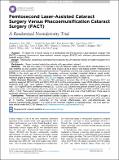Femtosecond laser-assisted cataract surgery versus phacoemulsification cataract surgery (FACT) : a randomized noninferiority trial
Abstract
Purpose To report the 3-month results of a randomized trial (Femtosecond Laser-Assisted Cataract Trial [FACT]) comparing femtosecond laser-assisted cataract surgery (FLACS) with standard phacoemulsification cataract surgery (PCS). Design Multicenter, randomized controlled trial funded by the UK National Institute of Health Research (HTA 13/04/46/). Participants Seven hundred eighty-five patients with age-related cataract. Methods This trial took place in 3 hospitals in the UK National Health Service (NHS). Randomization (1:1) was stratified by site, surgeon, and 1 or both eyes eligible using a secure web-based system. Postoperative assessments were masked to the allocated intervention. The primary outcome was unaided distance visual acuity (UDVA) in the study eye at 3 months. Secondary outcomes included corrected distance visual acuity, complications, and patient-reported outcomes measures. The noninferiority margin was 0.1 logarithm of the minimum angle of resolution (logMAR). ISRCTN.com registry, number ISRCTN77602616. Main Outcome Measures We enrolled 785 participants between May 2015 and September 2017 and randomly assigned 392 to FLACS and 393 to PCS. At 3 months postoperatively, mean UDVA difference between treatment arms was −0.01 logMAR (−0.05 to 0.03), and mean corrected distance visual acuity difference was −0.01 logMAR (95% confidence interval [CI], −0.05 to 0.02). Seventy-one percent of both FLACS and PCS cases were within ±0.5 diopters (D) of the refractive target, and 93% of FLACS and 92% of PCS cases were within ±1.0 D. There were 2 posterior capsule tears in the PCS arm and none in the FLACS arm. There were no significant differences between arms for any secondary outcome. Conclusions Femtosecond laser-assisted cataract surgery is not inferior to conventional PCS surgery 3 months after surgery. Both methods are as good in terms of vision, patient-reported health, and safety outcomes at 3 months. Longer-term outcomes of the clinical effectiveness and cost-effectiveness are awaited.
Citation
Day , A C , Burr , J M , Bennett , K , Bunce , C , Doré , C J , Rubin , G S , Nanavaty , M A , Balaggan , K S , Wilkins , M R & FACT trial group 2020 , ' Femtosecond laser-assisted cataract surgery versus phacoemulsification cataract surgery (FACT) : a randomized noninferiority trial ' , Ophthalmology , vol. 127 , no. 8 , pp. 1012-1019 . https://doi.org/10.1016/j.ophtha.2020.02.028
Publication
Ophthalmology
Status
Peer reviewed
ISSN
0161-6420Type
Journal article
Description
The trial was funded by the National Institute of Health Research (NIHR) Health Technology Assessment Panel (project reference number HTA 13/04/46 and was sponsored by University College London (UCL).Collections
Items in the St Andrews Research Repository are protected by copyright, with all rights reserved, unless otherwise indicated.

